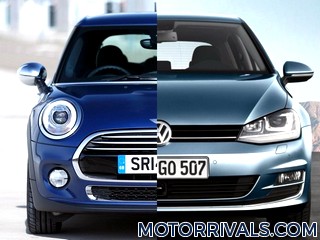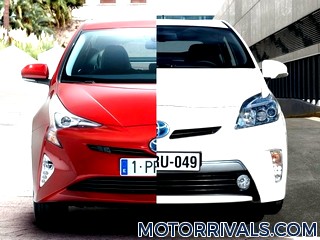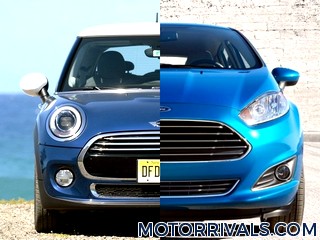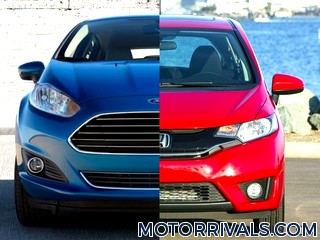2017 Hyundai Ioniq vs 2016 Toyota Prius
Hyundai Press Release Highlights
The Hyundai Ioniq eco-focused vehicle is the first in the world to offer
three distinct electrified powertrains on a single, dedicated vehicle
platform with the Ioniq Hybrid, Plug-in Hybrid, and Electric models.
Hyundai's approach for the Ioniq line delivers the latest in safety and
convenience technologies. A sporty, hatchback-like profile is inspired
by aerodynamic efficiency and produces a class-leading 0.24 coefficient
of drag. The front of the Hyundai Ioniq Hybrid is characterized by the
Bi-Xenon HID headlights surrounded by C-shaped LED positioning lamps. In
addition to general exterior design details from the Hybrid, such as the
hexagonal grille and the vertical C-shaped LED daytime running lights,
the Ioniq Plug-in also features low-beam LED headlamps. Hyundai Ioniq
Electric conveys a unique front perspective: without a need for
extensive powertrain cooling, the grille is a sleek and clean surface.
• Ioniq Hybrid and Plug-in - Six-speed EcoShift® dual-clutch transmission (DCT)
• Ioniq Hybrid and Plug-in - Electric motor - estimated 32 kW (43 horsepower) with an estimated maximum torque of 125 lb.-ft.
• Ioniq Hybrid and Plug-in - Lithium-ion polymer battery with 1.56 kWh capacity
• Ioniq Hybrid and Plug-in - Estimated total system output of 139 horsepower
• Ioniq Plug-in Hybrid - estimated all-electric range of more than 25 miles - estimated 45kW (60 horsepower) electric motor is coupled with the 1.6 direct-injected Atkinson four-cylinder Kappa engine
• Ioniq Electric - 28 kWh lithium-ion polymer battery for an estimated driving range of 110 miles - estimated maximum output of 88 kW (120 horsepower) and 215 lb.-ft. of torque through a single-speed reduction gear transmission.
• Ioniq Electric has an estimated 125 MPGe rating
• Electric power for the Hybrid and the Plug-in, as well as for the Electric, is generated by a permanent magnet synchronous motor
• Lithium-ion polymer battery pack for all Ioniq models which is 20 percent lighter than non-polymer lithium-ion batteries
• Charging the Ioniq Electric's lithium-ion polymer battery up to 80 percent only takes about 20 minutes using a SAE Combo Level 3 DC, 100 kW fast-charger. An integrated In-Cable Control Box (ICCB) also allows drivers to charge their Ioniq at a standard household electric socket.
• Lead-acid auxiliary 12V battery found in competitors' hybrid models has been omitted, resulting in an approximate 26-pound reduction in weight
• Damping in the floor panels, as well as enhanced A- and B- pillar insulation, thicker window glass and noise-cancelling film on the windshield, further improve the quiet and comfortable driving experience.
• Multi-link rear suspension system with dual lower control arms
• Extensive use of aluminum in front and rear suspension components saves around 26 lbs. of weight compared with conventional materials.
• Placement of the battery systems below the rear seats provides a lower center of gravity for more responsive handling
• Ioniq Electric applies a torsion-beam rear axle, providing more space for the 28 kWh lithium-ion polymer batteries, placed below the rear seats.
• Quick steering ratio for a sporty and responsive feel
• Braking force is optimized for maximum efficiency from the regenerative braking system, helping Ioniq to maintain a steady state of charge (SOC).
• Integrated Brake Assist Unit (iBAU) and Pressure Source Unit (PSU) - helps ensure ultra-low friction for maximum energy recuperation and efficiency levels.
• Michelin® low-rolling-resistance tires for 15-, 16- and 17-inch wheels, plus the car's larger 17-inch wheels (Ioniq Hybrid) are fitted with high-silica tires for better all-around performance.
• Apple CarPlay® and Android Auto® - both systems enable users to connect their devices to activate music, telephone or navigation functions with lower distraction levels.
• Wireless inductive-charging pad (Qi standard) for mobile phones
• Blue Link® connected car system with enhanced safety, diagnostic, remote and guidance services - brings connectivity directly into the car with technology like Remote Start with Climate Control, Destination Search powered by Google®, Remote Door Lock/Unlock, Car Finder, Enhanced Roadside Assistance, and Stolen Vehicle Recovery.
• 53 percent Advanced High Strength Steel
• Active safety features includes Blind Spot Detection, which works with Lane Change Assist and Rear Cross-Traffic Alert to warn the driver of any surrounding vehicles, passengers or objects that could lead to a collision.
• A Lane Departure Warning System (LDWS) is also offered, which sounds an alarm as the car moves over lane lines.
• Automatic Emergency Braking (AEB) with Pedestrian Detection, an advanced active safety feature that alerts drivers to emergency situations, even braking automatically as required
• Smart Cruise Control - allows a constant speed and following distance to be maintained from the vehicle ahead without depressing the accelerator or brake pedals
• Tire Pressure Monitoring System - helps ensure each individual tire is properly inflated
• A total of seven airbags, including a knee airbag for the driver, help protect the vehicle's occupants in the event of a collision.
Powertrain
• Ioniq Hybrid and Plug-in - New Kappa 1.6 direct-injected Atkinson-cycle four-cylinder engine - estimated 104 horsepower and an estimated 109 lb.-ft. of torque• Ioniq Hybrid and Plug-in - Six-speed EcoShift® dual-clutch transmission (DCT)
• Ioniq Hybrid and Plug-in - Electric motor - estimated 32 kW (43 horsepower) with an estimated maximum torque of 125 lb.-ft.
• Ioniq Hybrid and Plug-in - Lithium-ion polymer battery with 1.56 kWh capacity
• Ioniq Hybrid and Plug-in - Estimated total system output of 139 horsepower
• Ioniq Plug-in Hybrid - estimated all-electric range of more than 25 miles - estimated 45kW (60 horsepower) electric motor is coupled with the 1.6 direct-injected Atkinson four-cylinder Kappa engine
• Ioniq Electric - 28 kWh lithium-ion polymer battery for an estimated driving range of 110 miles - estimated maximum output of 88 kW (120 horsepower) and 215 lb.-ft. of torque through a single-speed reduction gear transmission.
• Ioniq Electric has an estimated 125 MPGe rating
• Electric power for the Hybrid and the Plug-in, as well as for the Electric, is generated by a permanent magnet synchronous motor
• Lithium-ion polymer battery pack for all Ioniq models which is 20 percent lighter than non-polymer lithium-ion batteries
• Charging the Ioniq Electric's lithium-ion polymer battery up to 80 percent only takes about 20 minutes using a SAE Combo Level 3 DC, 100 kW fast-charger. An integrated In-Cable Control Box (ICCB) also allows drivers to charge their Ioniq at a standard household electric socket.
Chassis
• Ioniq uses aluminum in the hood and tailgate• Lead-acid auxiliary 12V battery found in competitors' hybrid models has been omitted, resulting in an approximate 26-pound reduction in weight
• Damping in the floor panels, as well as enhanced A- and B- pillar insulation, thicker window glass and noise-cancelling film on the windshield, further improve the quiet and comfortable driving experience.
• Multi-link rear suspension system with dual lower control arms
• Extensive use of aluminum in front and rear suspension components saves around 26 lbs. of weight compared with conventional materials.
• Placement of the battery systems below the rear seats provides a lower center of gravity for more responsive handling
• Ioniq Electric applies a torsion-beam rear axle, providing more space for the 28 kWh lithium-ion polymer batteries, placed below the rear seats.
• Quick steering ratio for a sporty and responsive feel
• Braking force is optimized for maximum efficiency from the regenerative braking system, helping Ioniq to maintain a steady state of charge (SOC).
• Integrated Brake Assist Unit (iBAU) and Pressure Source Unit (PSU) - helps ensure ultra-low friction for maximum energy recuperation and efficiency levels.
• Michelin® low-rolling-resistance tires for 15-, 16- and 17-inch wheels, plus the car's larger 17-inch wheels (Ioniq Hybrid) are fitted with high-silica tires for better all-around performance.
Technology
• High-definition 7-inch TFT information cluster - displays all gauge functions (speedometer, drive mode, fuel level).• Apple CarPlay® and Android Auto® - both systems enable users to connect their devices to activate music, telephone or navigation functions with lower distraction levels.
• Wireless inductive-charging pad (Qi standard) for mobile phones
• Blue Link® connected car system with enhanced safety, diagnostic, remote and guidance services - brings connectivity directly into the car with technology like Remote Start with Climate Control, Destination Search powered by Google®, Remote Door Lock/Unlock, Car Finder, Enhanced Roadside Assistance, and Stolen Vehicle Recovery.
Safety
• Body structure improvements, complemented by a high-strength fiber-reinforced rear bumper fascia make the entire Ioniq line-up strong and durable in the event of a crash.• 53 percent Advanced High Strength Steel
• Active safety features includes Blind Spot Detection, which works with Lane Change Assist and Rear Cross-Traffic Alert to warn the driver of any surrounding vehicles, passengers or objects that could lead to a collision.
• A Lane Departure Warning System (LDWS) is also offered, which sounds an alarm as the car moves over lane lines.
• Automatic Emergency Braking (AEB) with Pedestrian Detection, an advanced active safety feature that alerts drivers to emergency situations, even braking automatically as required
• Smart Cruise Control - allows a constant speed and following distance to be maintained from the vehicle ahead without depressing the accelerator or brake pedals
• Tire Pressure Monitoring System - helps ensure each individual tire is properly inflated
• A total of seven airbags, including a knee airbag for the driver, help protect the vehicle's occupants in the event of a collision.
Toyota Press Release Highlights
The all-new fourth-generation 2016 Toyota Prius liftback is a new
version of the global green icon that takes the hybrid concept farther
than ever with striking design, with expected higher fuel economy
ratings, and greater ride comfort. The shape may be familiar, but the
new Prius is longer, lower and wider than its esteemed predecessors, to
offer more interior room and provide a more planted stance for handling
agility. Aerodynamic goals inspired the shape to help Prius score an
increase in fuel economy ratings over the previous model. The 2016 Prius
is anticipating fuel economy ratings of 54 MPG city / 50 MPG highway /
52 MPG combined (Final EPA figures pending.). A new Eco grade model is
expecting ratings of 58 MPG city / 53 MPG highway / 56 MPG combined
thanks to lighter weight and further optimized aerodynamics. The new
Prius comes in six grades, catering to a wide variety of tastes and
needs. The new grade strategy includes: entry level Prius Two; Prius Two
Eco; Prius Three; Prius Three Touring; Prius Four; Prius Four Touring.
• Electronically controlled planetary-type continuously variable transmission (CVT)
• New lithium-ion hybrid battery replaces the nickel-metal hydride battery (excluding the Prius Two non-Eco grade) in most models.
• New shift-by-wire technology uses electric signals to transmit shift operations and offers light, fingertip operation from the dash-mounted shifter.
• New selectable Normal and Power driving modes. Normal balances both fuel economy and acceleration feel; Power prioritizes acceleration feel.
• Retuned 2ZR-FXE 1.8-liter gasoline engine achieves 40 percent-plus thermal efficiency
• An automatic grille shutter reduces drag by closing when airflow to the radiator is not needed
• Toyota’s New Global Architecture (TNGA) - new high-strength body structure, new double-wishbone independent rear suspension and low center of gravity
• 2.4 inches longer, 0.6 inches wider and 0.8 inches lower than the model it replaces (on the same 106.3-in. wheelbase)
• 17-inch wheels and 215/45R17 tires and special suspension tuning
• Alloy 15-inch wheels on other grades are a half-inch wider than before (now 6.5 in.)
• Double wishbone rear suspension – replaces the torsion beam type suspension used on previous models
• Regenerative brake system - switches the motor into a generator to recover kinetic energy
• Electronically Controlled Brake System - uses sensors to detect how much the driver is pressing the brake pedal and determines how much brake force is required from the new active hydraulic brake booster.
• Steering wheel controls
• Display background color changes depending on selected driving mode
• Simple or Segmented display modes
• Simple mode shows a large vehicle speed display, remaining fuel, drive mode indicator, outside temperature, odometer functions and cruising range.
• Segmented display presents more detail about hybrid operation, including instantaneous fuel economy, hybrid battery state of charge and a suite of ECO functions to encourage efficient driving habits.
• Entune Audio systems - standard on Prius Two and Prius Two Eco grades includes the Entune Multimedia Bundle (6.1 in. touch-screen display, AM/FM CD player, six speakers, auxiliary audio jack, USB 2.0 port with iPod® connectivity and control, advanced voice recognition, hands-free phone capability, phone book access and music streaming via Bluetooth® wireless technology), plus Siri® Eyes Free mode and an integrated backup camera display.
• On all other grades, the standard Entune Premium Audio with Integrated Navigation system and Entune App Suite® includes all of those features plus a seven-inch high resolution touch-screen with split screen display, Entune App Suite, HD radio, HD predictive traffic and Doppler weather overlay, AM/FM cache radio, SiriusXM All Access Radio with 3-month complimentary trial and Gracenote album cover art.
• As part of a package, the Prius Four grade exclusively offers the Entune Premium JBL® Audio system with Integrated Navigation and App Suite. To all features of the base and middle systems, it adds 10 JBL GreenEdge™ speakers in eight locations.
• Vehicle Proximity Notification System - helps alert pedestrians and cyclists with a speaker that emits a low warning tone when traveling below approximately 15 mph
• The high-strength Prius cabin is enhanced for occupant protection in a collision, while inside, a full array of supplemental restraint system (SRS) airbags includes multi-stage driver and front passenger SRS dual-stage front airbags; driver and front passenger SRS side airbags; full-length SRS curtain airbags; a driver SRS knee airbag, and a front passenger SRS seat cushion airbag.
• Available Intelligent Parking Assist (IPA) - activated by the driver to offer automatic steering into parallel parking spaces, or reversing into perpendicular spaces. The system also offers automatic steering to exit a parallel space.
• Intelligent Clearance Sonar - provides visible and audible warnings if the driver gets too close to obstacles on the vehicle’s sides.
Value Pricing
The manufacturer’s suggested retail price (MSRP) for the 2016 Prius will range from $24,200 for the Prius Two model to $30,000 for the Prius Four Touring.
Powertrain
• Hybrid Synergy Drive combines the output of a 1.8-liter 4-cylinder gasoline engine and two motor/generators• Electronically controlled planetary-type continuously variable transmission (CVT)
• New lithium-ion hybrid battery replaces the nickel-metal hydride battery (excluding the Prius Two non-Eco grade) in most models.
• New shift-by-wire technology uses electric signals to transmit shift operations and offers light, fingertip operation from the dash-mounted shifter.
• New selectable Normal and Power driving modes. Normal balances both fuel economy and acceleration feel; Power prioritizes acceleration feel.
• Retuned 2ZR-FXE 1.8-liter gasoline engine achieves 40 percent-plus thermal efficiency
Chassis
• 0.24 coefficient of drag (Cd)• An automatic grille shutter reduces drag by closing when airflow to the radiator is not needed
• Toyota’s New Global Architecture (TNGA) - new high-strength body structure, new double-wishbone independent rear suspension and low center of gravity
• 2.4 inches longer, 0.6 inches wider and 0.8 inches lower than the model it replaces (on the same 106.3-in. wheelbase)
• 17-inch wheels and 215/45R17 tires and special suspension tuning
• Alloy 15-inch wheels on other grades are a half-inch wider than before (now 6.5 in.)
• Double wishbone rear suspension – replaces the torsion beam type suspension used on previous models
• Regenerative brake system - switches the motor into a generator to recover kinetic energy
• Electronically Controlled Brake System - uses sensors to detect how much the driver is pressing the brake pedal and determines how much brake force is required from the new active hydraulic brake booster.
Technology
• Dual 4.2-inch full-color TFT (Thin Film Transistor) multi-information displays• Steering wheel controls
• Display background color changes depending on selected driving mode
• Simple or Segmented display modes
• Simple mode shows a large vehicle speed display, remaining fuel, drive mode indicator, outside temperature, odometer functions and cruising range.
• Segmented display presents more detail about hybrid operation, including instantaneous fuel economy, hybrid battery state of charge and a suite of ECO functions to encourage efficient driving habits.
• Entune Audio systems - standard on Prius Two and Prius Two Eco grades includes the Entune Multimedia Bundle (6.1 in. touch-screen display, AM/FM CD player, six speakers, auxiliary audio jack, USB 2.0 port with iPod® connectivity and control, advanced voice recognition, hands-free phone capability, phone book access and music streaming via Bluetooth® wireless technology), plus Siri® Eyes Free mode and an integrated backup camera display.
• On all other grades, the standard Entune Premium Audio with Integrated Navigation system and Entune App Suite® includes all of those features plus a seven-inch high resolution touch-screen with split screen display, Entune App Suite, HD radio, HD predictive traffic and Doppler weather overlay, AM/FM cache radio, SiriusXM All Access Radio with 3-month complimentary trial and Gracenote album cover art.
• As part of a package, the Prius Four grade exclusively offers the Entune Premium JBL® Audio system with Integrated Navigation and App Suite. To all features of the base and middle systems, it adds 10 JBL GreenEdge™ speakers in eight locations.
Safety
• Toyota Safety Sense P (TSS (P)) - new multi-feature advanced safety package anchored by automatic pre-collision braking. TSS bundles cutting edge safety technologies including Pre-Collision System with Pedestrian Detection; Lane Departure Alert with Steering Assist; Full-Speed Dynamic Radar Cruise Control, and Automatic High Beams.• Vehicle Proximity Notification System - helps alert pedestrians and cyclists with a speaker that emits a low warning tone when traveling below approximately 15 mph
• The high-strength Prius cabin is enhanced for occupant protection in a collision, while inside, a full array of supplemental restraint system (SRS) airbags includes multi-stage driver and front passenger SRS dual-stage front airbags; driver and front passenger SRS side airbags; full-length SRS curtain airbags; a driver SRS knee airbag, and a front passenger SRS seat cushion airbag.
• Available Intelligent Parking Assist (IPA) - activated by the driver to offer automatic steering into parallel parking spaces, or reversing into perpendicular spaces. The system also offers automatic steering to exit a parallel space.
• Intelligent Clearance Sonar - provides visible and audible warnings if the driver gets too close to obstacles on the vehicle’s sides.
Value Pricing
The manufacturer’s suggested retail price (MSRP) for the 2016 Prius will range from $24,200 for the Prius Two model to $30,000 for the Prius Four Touring.






















